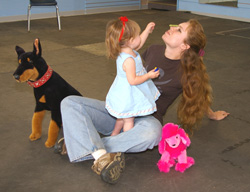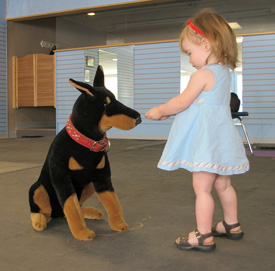Oh, the possibilities
Hey, this stuff works across species!
This isn't really news. Most of us know that operant conditioning is the primary method of learning, and the best method for teaching across the animal kingdom. But sometimes it's easy to forget that it works just as well on people.

I'm not talking about TAGteachTM, which is wonderful in its own way. TAGteach is oriented toward formal instruction, similar to the formal training sessions we have with our pets. But, just as great trainers incorporate operant conditioning seamlessly into everyday interactions with their pets, even outside of conscious training, we can use our training knowledge to influence the behavior of people around us.
Like a shrieking toddler.
Emma
Now, please don't misunderstand me; fifteen-month-old Emma was not having a tantrum. She had just discovered a new thrill—leaning against a fitness ball as I slouched in an overstuffed chair and dribbled the ball rapidly with my heels. The buzzing vibration of the ball and the throbbing hum as it bounced delighted her. Her shrieks were pure joy.
"I'd always thought roller coaster screaming was a learned behavior," my sister commented, observing. "But it must be innate!"
That day I had a headache already, and a toddler's shrieking was not improving it. Her mother recognized my disinclination to hear loud high-pitched noises and started forward to collect the child. But it wasn't Emma's fault that I had a headache, and there was no reason she couldn't enjoy the ball without screaming. She had waited patiently through our meeting, and now that we were finished she wanted to play. I wasn't upset; I just didn't want to hear shrieking.
Using negative punishment positively
It has become somewhat fashionable of late to criticize the use of negative punishment. While I certainly don't advocate punishment as a primary training tool, we shouldn't completely discard its utility. Reinforcement is obviously the best choice, teaching new behavior or replacing unwanted behavior with incompatible behavior. But occasionally we do need to stop an undesirable behavior, and we may need to do it more quickly than by shaping. This is where negative punishment might be considered.
I began drumming again, and Emma leaned into the ball joyfully. After a few seconds, she gave a piercing, gleeful shriek and, instantly, I stopped the ball's movement. Emma stared at the ball, puzzled. I began dribbling again, my heels drumming rapidly. She leaned into the ball and this time lasted about ten seconds before shrieking. The ball stopped.
By now, the other two trainers in the room knew what I was doing and they were grinning. Others in the room stared, trying to guess at my odd behavior, and at the meaning of the knowing glances we three trainers were exchanging. I began the ball's quick bouncing again, and Emma focused intently on it, her eyes shining with delight. No shrieking. I continued drumming (automatically counting seconds) for nearly a full minute, and while Emma beamed and laughed, she never once squealed or shouted.
I wasn't the only one counting. "Fifty-two seconds," my sister announced when I finally gave my legs a rest. "Up from ten last time. Four reps total."
I am certain that if I had tried to reprimand Emma or explain to her that her noise was unacceptable, I would have ruined her fun and probably had less success. Emma is far too young to understand long-winded rationalization, never mind the inherent social confrontation. Proper, impersonal use of negative punishment meant that I could selectively discourage only the unwanted behavior—the shrieking—without suppressing her entire interaction with me.
(It's also vitally important to note that I had to reinforce the quiet play as well! I restarted the dribbling during her puzzled silence and it continued for a much longer time while she was quiet; I could not arbitrarily stop or I'd risk losing the association she'd made.)
Negative punishment vs. extinction and shaping
Negative punishment differs from extinction, though the two can appear similar.
Negative punishment differs from extinction, though the two can appear similar. Extinction is simply a lack of response, an utter failure to affect the environment. When Emma is fussing in her chair, demanding food or attention with more insistence than is mannerly, we become strangely deaf, failing to notice her flailing. When she recalls how to request a bite of food by asking "More?" rather than by shaking a fist, she gets a prompt response. Shaping at mealtime!
Choosing, and timing, negative punishment
Negative punishment is not needed for teaching new behavior, and because it is punishment it shouldn't be used often. It can frustrate the subject, suppress experimentation and learning, and it requires exquisite timing. (Imagine the chaos if I had stopped the ball bouncing even a second or two after Emma's shriek!) It can also be confrontational if not done well. But for interrupting a behavior that cannot wait for extinction or replacement, negative punishment is a useful technique.
Emma again—now she's hitting me!
Not long ago, Emma entered an experimental hitting phase, which isn't uncommon among toddlers. Emma, a committed social butterfly, tried slapping nearly everyone who held her. The range of responses was wide—some people grabbed her hand and verbally reprimanded her, some tried to block her from reaching a facial target, some sweetly explained that hitting wasn't nice, and others slapped her and scolded, "Don't hit people!"
None of these responses seemed to have a lasting effect. Emma often struck immediately again, and the reason was clear to a behavior analyst. Emma was on a variable schedule of reinforcement for hitting, making the behavior resistant to extinction—and very annoying. It was only a matter of time before someone got really fed up with Emma and applied a major aversive.
One day Emma slapped me. Without thinking, I spun her in my arms so that she was suddenly facing outward, unable to reach me, and I continued a conversation with her mother. Emma was momentarily stunned, squirming to turn back toward me, but I held her firmly and ignored the minor extinction burst. When Emma quieted, I turned her toward me again and carried on as if nothing had happened.
My brain caught up with my body's actions; I had just negatively punished Emma for hitting me, by removing access and attention. What's more, it had worked. Emma did not hit me again that day or the next. In fact, she has not hit me ever since.
Negative punishment has its place in the parenting tool bag

Now, I cannot pretend that a single application of negative punishment is a panacea for childhood misbehavior. Emma had no history of reinforcement for hitting me; the first attempt met with instant failure, and so there was no reason for her to try again. When Emma's mother—no slouch at operant conditioning herself—tried the technique, it took several tries before hitting was reduced, because of the variable history of reinforcement. Hitting still surfaces occasionally with other people, because there is still a chance of attention for misbehavior. But Emma hasn't slapped me again.
"You can't treat children like dogs," I've been chided, as if there is some divide that precludes the science of behavior crossing from the arena of animal training into the dignity of human behavior. I don't think of it that way. I'm glad to see that the wonderfully non-confrontational clicker techniques are tools for human interaction as well as for interspecies communication. I like to know that I can affect the behavior of a dog or a toddler with equal ease, and, in turn, they can communicate with me.
Clicker training, toddler-style
Let me share (brag?) that Emma will enthusiastically click and throw a kibble to her stuffed cow, though her criterion is a bit unclear. And she is teaching her toy fish to stay; apparently it's ready to work on distance. By the time she's two, Emma may be training her parents as much as they train her!



Let me puff it out loud: THANK YOU!
This was a really good surprise. Just reading the headline was a reinforcer to me. I am a dog trainer trying to cross over to coaching people via Positive Reinforcer and I enjoyed this article. It is clearly written, thought out and amusing.
Please give us more.
More please!
Laura, I can't tell you how excited I was to see this headline today! I have a toddler myself, who is now in the annoying, independent, I-want-to-do-everything-myself-even-if-it-isn't-physically-possible stage, and is also starting to get into the I-don't-have-to-do-what-you-say-if-I-just-run-away-shouting-"you can't catch me" stage. *sigh*
I've been trying to figure out more ways to use clicker training ideas on her, but wow, it's tough to think of things like that when she's running away from you in the middle of the drug store while you're standing at the front of a very long line at the pharmacy counter...
I have been using negative punishment quite successfully on the whole staying in bed at night issue. She gets up, I take her back to bed. I don't say anything, I don't play with her, or hug her, or rock her, or anything. It works quite well. I was gone for 3 weeks on a business trip, during which time my husband and the two grandmas both gave in to her and rocked her, or held her, or let her play, for an hour or more. I came home and there would be no more of that!! The very first night she only got up four times, over about 15 minutes, and that was it, she stayed in bed. Now if only I could figure out how to get my husband to realize that I'm right and stay consistent with that method. *sigh*
Anyhow, thanks for this article, I enjoyed it very much. I'd love to see more "toddler training" stories!
Michelle
P.S. My daughter "trains" her stuffed animals too. She also likes to pretend she's a dog and tries to get in on the action when I'm handing out clicks and hot dogs... ;-)
Post new comment